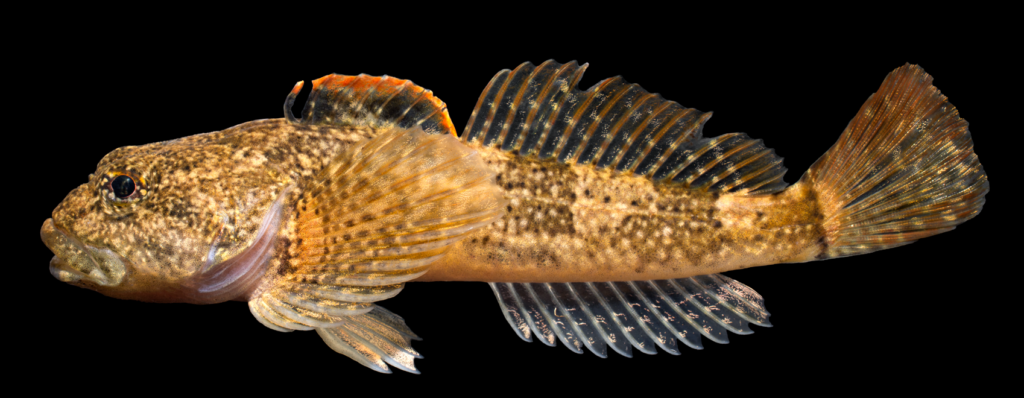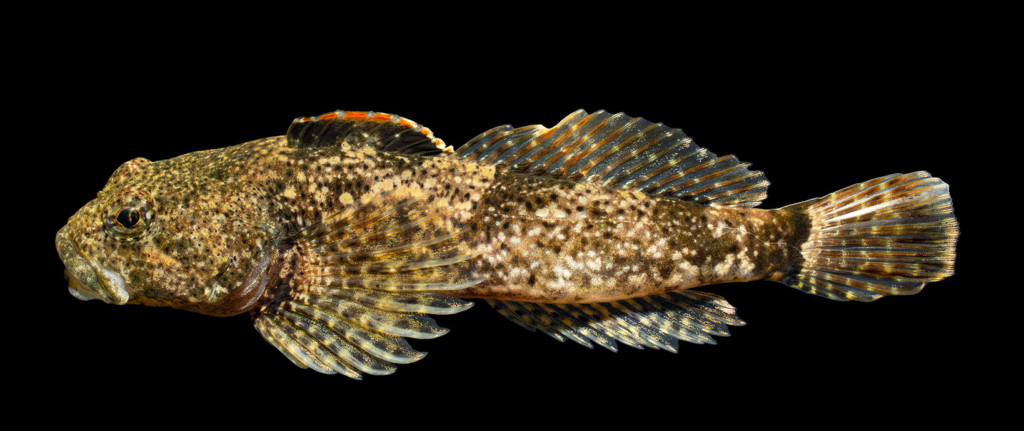By the NCFishes.com Team
North Carolina is home to three species of sculpins: Mottled Sculpin, Cottus bairdii, Blue Ridge Sculpin, Cottus caeruleomentum, and Banded Sculpin, Cottus carolinae (Tracy et al. 2020). [Please note: Tracy et al. (2020) may be downloaded for free at: https://trace.tennessee.edu/sfcproceedings/vol1/iss60/1.] Sculpins, to the lay-person, are often called molly crawlbottom, miller’s thumb (in reference to the shape of a miller’s thumb (https://williamrubel.com/2016/09/09/the-millers-thumb/), wartfish, and muddler, but the American Fisheries Society-accepted common names are Mottled Sculpin, Blue Ridge Sculpin, and Banded Sculpin (Page et al. 2013) and each of their scientific (Latin) name actually means something (please refer to The Meanings of the Scientific Names of Sculpins, page 6).

Sculpin are unusual looking small brown fish with big eyes atop a large, wide head, a large mouth, what appears to be a scaleless body, and big pointy fins. They often go unnoticed because they are cryptically colored to blend in with coarse substrates (i.e., large gravel, cobble and boulder) under which they often hide. They may be found in riffles and runs in fast flowing, clear cool to cold water trout-type streams in our mountain river basins. In North Carolina, sculpins as a whole do not get very big. They range in size from about 80 mm Standard Length (3.1 inches) for Blue Ridge Sculpin, about 91 mm Standard Length (3.6 inches) for Mottled Sculpin, and about 144 mm Standard Length (5.7 inches) for Banded Sculpin (Jenkins and Burkhead 12994; Kinziger et al. 2000).

Historically, no species were found east of the Appalachian Mountains, except for the Blue Ridge Sculpin in the upper Roanoke basin and the Mottled Sculpin in the upper Savannah basin (Maps 1-3). Mottled Sculpin, our most widely distributed and commonly collected species, is indigenous (native) in all river basins west of the Mountains, including the New and the Savannah (Map 1). However, it is nonindigenous (introduced probably by bait-bucket introductions) in the upper Broad basin in Polk, Henderson, and Buncombe counties. [Note: see Supplemental Maps 1-3 , page 8, showing North Carolina’s 100 counties, 21 river basins, and 4 physiographic regions.]. Blue Ridge Sculpin, our most restricted species and the only species of sculpin in the Roanoke basin, is found only in the Little Dan River and the mainstem of the Dan River upstream from the Little Dan River to the North Carolina-Virginia state line in Stokes County (Map 2; Tracy et al. 2020). Banded Sculpin, generally larger than Mottled Sculpin, also has a limited distribution. Currently, it is found only in the lower French Broad River and Shut-in Creek near Hot Springs, and French Broad River at Marshall (Madison County, French Broad basin) and from the Pigeon River downstream from Walters Lake into the gorge and in Big Creek (Haywood County, Pigeon basin; Map 3) (Tracy 2020). Mottled and Banded Sculpin do not appear to be co-occur (i.e., be sympatric) in North Carolina.

Both the Blue Ridge Sculpin and Banded Sculpin are listed as State Special Concern species because of their limited distributions and the potential anthropogenic impacts upon their habitats and stream water quality (NCAC 2017; NCNHP 2020; NCWRC 2017).
At the present time, their identification is “relatively” straight-forward. However, the taxonomic status of Mottled Sculpin in North Carolina has been unsettled for a long time (e.g., Jenkins and Burkhead 1994) and some researchers and museums record the species as Cottus bairdii complex or Cottus sp. (Gabriela M. Hogue, North Carolina Museum of Natural Sciences, pers. comm.). Until their taxonomy is resolved, any sculpin, except for the Banded Sculpin, found in our western Mountain streams is being called Mottled Sculpin (Tracy et al. 2020). Blue Ridge Sculpin is the only sculpin one would encounter in the upper Dan River system. Likewise, Banded Sculpin is the only species in the Pigeon River basin near the Tennessee-North Carolina state line and in the French Broad basin also near the state line. Mottled Sculpin is everything else.
Key characteristics for their proper identification include the pigmentation pattern of the caudal band and lateral bars, the number of pectoral fin rays, the number of preopercular spines, the size and shape of the uppermost preopercular spine, and the size of the palantine tooth patch in relation to the size of the vomerine tooth patch (please refer to the Identification Key to the Species of Sculpins (Family Cottidae) in North Carolina). Preopercular spines are best observed by examining the preserved specimen beneath a dissecting microscope and cutting away the overlying tissue. Palantine teeth and vomerine teeth are also best observed on preserved specimens using a dissecting microscope.
If you have troubles with your identifications, just send us (https://ncfishes.com/contact/) an e-mail and include as many quality digital photographs as you can along with all the pertinent locality descriptors so that we will know from where the fish came.